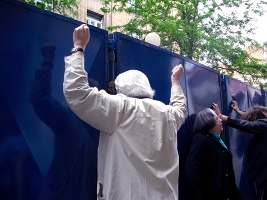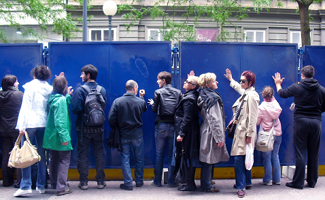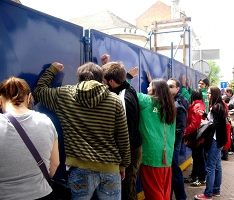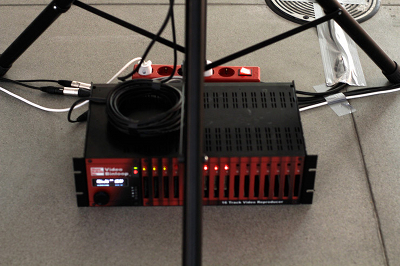Picture of Sound is a programme that was launched on Croatian
Radio Three in 2009. The intention behind it was that, in
addition to the critical coverage of contemporary art aired in other
programmes, we should provide the possibility for works of art to be
created in the programme and to be performed for the first time on the
air. We wanted, that is, to encourage a particular kind of audio work,
i.e., sound art, which is a branch of contemporary multimedia artistic
practices, the origins of which lie principally in visual and
conceptual art. At the same time, thanks to the capacities of the radio
medium, these works were able to be diffused much more widely than
would have been the case had they been performed in, for example, a
gallery presentation.
From the launch of Picture of Sound until the end of 2012, forty works
were produced and broadcast on Croatian Radio Three. Of these, the
first 18 (made from 2009 until the first half of 2010), after being
broadcast as part of regular programming, were set down for posterity
on a DVD called Picture of Sound released at the end of 2010. On this
present record, all the audio works of visual artists created from mid
2010 to the end of 2012 have been collected.
Evelina Turković
Editor, Picture of Sound
(Translated into English: Graham McMaster)
PDF oft he booklet oft he DVD Slika od Zvuka 2: http://radio.hrt.hr/data/files/0c062dd50bed09a6491da9b8202f005073fbd259.pdf
1) „How we knocked down the fence in Varšavska Street“ by Sanja Ivekovic
(18'51'')
  
Broadcast: 21st November 2010
Sound engineer: Tomislav Šamec
Our gratitude goes to Fade In and the camerman Lovro Čepelak for providing the sound recording.
The artistic activity of Sanja Iveković, ever since 1970-ies when she
was among the first in our midst to begin working in the medium of
video, performance or videoperformance, no matter how diverse it is in
terms of its themes and media, can still be placed within the general
topic of the relation between the private and public. In the beginning,
during the 1970-ies and 1980-ies, the dominant question concerned the
artist’s personal placing within the society or the relation
which she as an individual achieved towards a major group of people in
her immediate surroundings. The individual figure of a real woman in
conflict with her specific roles, tailored to fit the social
stereotypes, prejudices or images imposed by media, develops alongside
as a major, and since that time permanent, subject matter in the work
of Sanja Iveković. The effect of defamiliarization is produced by the
language of the medium itself. Sanja Iveković acts similarly in her
public works and in the works where she delivers direct political
messages. What we have here is an infiltration into the actual
condition, which then adapts itself changing its semantics in the
favour of a particular problem’s public announcement. The effect
may be compared, said Bojana Pejić, while writing about the public
works of Sanja Iveković, with 'public cuts'.
The audio work of Sanja Iveković for the broadcast ‘Picture of
Sound’ was also made in this context. It was conceived as a cut
in the space of media which will try to memorize a certain moment, both
private (artist’s) and collective one. This is a work where Sanja
Iveković, to use the words of Bojana Pejić again, 'primarily works with
and against exclusion from the public, with questions, processes and/or
relations which begin to lose their social invisibility through her
artistic works.’
E.T. (Translated into English: Dinko Telećan)
2) „Color of the Noise“ by Hrvoje Hirsl
(25’14”)

Broadcast: 22nd May 2011
Participation: Gordana Gojčeta
Preceding the audio-work for the program 'Picture of Sound' Hrvoje
Hiršl conceived of a work which literally transforms image into
sound. Intended as a diptych it represents two large black
screens suspended on the gallery wall to which from behind attaches
stereo equipment. The sound waves then vibrate the surface of the
canvas. The intention was an 'attempt to overcome technical
aspects of painting in order to reach the purest, most abstract image.'
This orientation toward the minimal, with references to the history of
contemporary art, to the beginning of abstract art, to suprematism, to
the authors like Malevich or Cage, is evident throughout the
Hiršl’s opus. Naturally, these references are only a
starting point, a center from which one is to continue exploration of
the contemporary issues. Thus the question of the medium is of crucial
importance. What happens to content in the case of the media
transmission? Can an error be exploited creatively when,
according to Hiršl, the medium becomes 'a producer and not
solely a reproducer'. Similarly, the installation '3 Narrators'
has shown the three stereo speakers with fractured membranes emitting
pure sound. Due to their flaw the sound took unpredictable turns
and gradually has became more and more distorted. The medium did
not remain a passive transmitter but has changed into an active factor
shaping the final auditive image.
White noise is often perceived as a sound with flaw or
interference. It does not contain any useful information; it is
defined as the sound without amplitude, or lacking pattern; it is
marked only by its continuity, the constant repetition of the same
frequency. White noise can be measured against the pure signal
which then determines its frequency spectrum. These are named by
colors: most often defined as white, but also pink, red, blue, purple
or gray noise.
These types of noise, sounds with zero content, or minimum of radio
transmission while broadcast are perceived as interference or side
effect in the radio transmission —they also represent the opening
point of the audio-work 'Color of the Noise'. With mathematical
precision and statistical arrangement, Hiršl transforms
them into an auditive subject matter. The white noise meanwhile
has not been changed, yet the simple process of editing has turned it
into its opposite, into the sound composition itself.
E.T. (Translated into English: Boris Gregorić)
3) „Tram Symphony“ by Mladen Stilinovic
(18'14”)
Broadcast: 20st November 2011
Sound engineer: Katarina Barišić
For the ‘Tram Symphony’, similar to the project of the
Group of Six from the middle of 1970's and their various conceptual
'exhibition-actions', Mladen Stilinović took to the streets to
record sounds of daily traffic. His approach was similar to his
other media work. To isolate a phenomenon —be it a color,
sentence or visual sign —from its natural environment, city
streets and daily life, and to use them as signs within a personal
vocabulary. The sign remains symbolic, but at the same time it
becomes ironic and de-symbolized. In the same vein Stilinović,
among other projects, took over and turned into absurdity the various
socialist era catchwords and slogans; for example those dealing with
the issues of labour and progress. When using color red this act
simultaneously represents a symbol for certain period of time; it also,
according to the author’s words, attempts to achieve the
'de-symbolized' status. Likewise, by rearranging headlines of the
day, he transforms them into his own slogans and catchwords...
Stilinović understands the broad social issue of Labor,
auto-referentially as the question of art and its value in the society
by using strong dosage of self-irony. Thus the series of
photographs depicting the artist asleep, taken between 1973 and 1983,
is ironically entitled 'The artist at work'. In 'Ode to Laziness'
Stilinović writes: “Artists from the East were lazy and
impoverished because the whole system of the extraneous factors such as
gallery and museum networking, the system of grant writing et al, did
not exist. Thus they had plenty of time to focus on —art and
laziness. And while they were producing the former, they knew it
was to no avail, that is was all good for nothing.” From
this it becomes apparent that Stilinović, under the guise of the absurd
and the comical, speaks of one of the possible ways in which artist
copes with the social context which neither accepts him nor places much
value upon his work.
E.T. (Translated into English: Boris Gregorić)
|

 PLAY EXCERPT
PLAY EXCERPT


